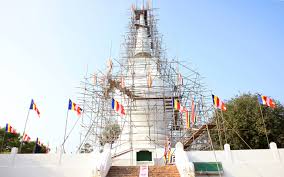-By Our Special Correspondent

(Lanka-e-News -16.Feb.2025, 7.30 PM) The Tissa Rajamaha Viharaya in Thaiyiddy, Jaffna, has become more than just a Buddhist temple. It is now a symbol of resistance, historical injustice, and political manipulation—a battleground where history, identity, and power collide. For Tamil communities in the North, the land on which this temple stands is not just soil—it is ancestral land, taken from them during decades of Sinhalisation efforts by the Sri Lankan state.
At the center of the controversy are two monks, Brahmanawaththe Damma Kiththi Thissa Thero of Nainatheevu and Kalutara Pandithaseela Dharatissa Thero of Kankesanthurai (KKS), who were registered as purchasers of the land and trustees of the Tissa temple. Their presence in Jaffna, a historically Tamil region, raises deep questions about state-backed land acquisitions, demographic changes, and the larger political agenda.
For decades, Tamil communities in the North have seen their lands occupied, confiscated, and repurposed by successive Sri Lankan governments. Under the pretext of Buddhist heritage, military expansion, and state development projects, large swathes of land have been taken over—often without due legal process or proper compensation.
The construction and expansion of Buddhist temples in Tamil-majority areas have been seen as part of a deliberate strategy of Sinhalisation—a process aimed at altering the region’s demographic and cultural landscape. The Tissa Rajamaha Viharaya is one such case, where a Buddhist temple stands on what was once Tamil land, reinforcing the deep scars of historical injustices.
As Sri Lanka attempts to navigate a new era of governance under the NPP government, certain political figures desperately cling to old tactics. Among them, Udaya Gammanpila and Sarath Weerasekara—two politicians known for their nationalist rhetoric and anti-Tamil sentiment—are actively working to stir ethnic tensions.
Their strategy is simple:
Manufacture a crisis. Tell the majority Sinhalese Buddhists in the South that Tamils are trying to remove Buddhist temples in the North.
Play the victim. Position Sinhalese Buddhists as being under threat, despite being the dominant majority.
Provoke a reaction. Use the fear of "Tamil extremism" to rally nationalist support, while derailing any chance of reconciliation between Tamils and Sinhalese.
In reality, Tamils are not asking for Buddhist temples to be destroyed. They are simply demanding the return of their ancestral lands, much of which remains under the control of the Sri Lankan military and government institutions.
The timing of this controversy is not a coincidence. For the first time in decades, a Sri Lankan government—the NPP administration—is making genuine efforts to bridge the ethnic divide and engage with the Tamil community. This is a nightmare for nationalist politicians like Gammanpila and Weerasekara, who thrive on ethnic polarization.
By manufacturing tensions around Tissa Rajamaha Viharaya, they are attempting to:
Undermine the NPP government by portraying it as “weak” on protecting Buddhist heritage.
Rally Sinhala-Buddhist voters against any Tamil land claims.
Disrupt Tamil-Sinhala reconciliation efforts, which could weaken their own political influence.
The reality is that the Tamil community is not anti-Buddhist. The demand for ancestral land is not about religion—it is about historical justice and the right to reclaim what was once theirs.
The resolution of this issue requires rational discussion, legal clarity, and political will. There are clear steps that could lead to a fair outcome:
A transparent land inquiry—independent investigations into historical land ownership.
Demilitarization of occupied lands—returning civilian lands currently controlled by the military.
Protection of all religious sites—ensuring Tamil Hindus and Christians also have access to their heritage sites.
Reconciliation efforts—Tamil and Sinhalese communities should engage in direct dialogue, without interference from nationalist politicians.
If handled with maturity and fairness, this issue could become a model for conflict resolution in Sri Lanka. However, if figures like Gammanpila and Weerasekara are allowed to weaponize religion and history for political gain, then the cycle of distrust and division will continue.
At its core, this is not a fight between Tamils and Sinhalese—this is a fight between those who want a peaceful, united Sri Lanka and those who profit from keeping the country divided. The question is: Which side will Sri Lanka choose?
-By Our Special Correspondent
---------------------------
by (2025-02-16 14:09:21)
Leave a Reply